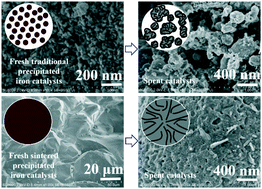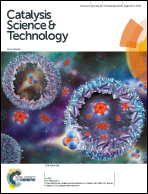Sintered precipitated iron catalysts with enhanced fragmentation-resistance ability for Fischer–Tropsch synthesis to lower olefins†
Abstract
Commercial precipitated iron catalysts suffer from severe fragmentation when applied in the Fischer–Tropsch to lower olefins reaction (FTO). Herein, sintered precipitated iron catalysts for FTO are prepared by varying the calcination temperature from 800 to 1400 °C to enhance their fragmentation-resistance ability. Compared with traditional precipitated iron catalysts, sintered precipitated iron catalysts require higher reduction temperatures to maintain high and stable activity and shift the production of hydrocarbons towards lower olefins. Spent sintered precipitated iron catalysts show bulk morphologies with less fragmentation than the fragmented and aggregated morphologies of spent traditional precipitated iron catalysts. The amount of coke inside the spent catalysts decreases from 41.8 to 12.5% as the calcination temperature increases from 500 to 1200 °C, and simultaneously, the chain length of soluble coke decreases from C32 to C21. The lower amount of coke and shorter chain length of soluble coke of the sintered precipitated iron catalysts come from the stronger mechanical strength-induced less space for coke accumulation during FTO, which further enhance the fragmentation-resistance ability of the catalysts.



 Please wait while we load your content...
Please wait while we load your content...